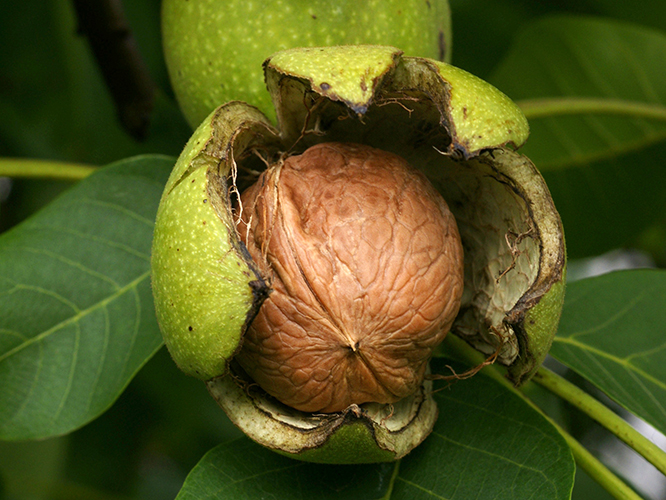#8 COMMON WALNUT
Juglans regia

This tree is at the bottom of the East Walk, on the W side.
County Champion
| Distribution: | Native to south east Europe, the Himalayas, northern Myanmar to south west China Widely planted throughout the UK. Naturalised in lowland Britain (helped along by hoarding squirrels), in secondary woodland and hedgerows; and on river banks, field-borders and roadsides. It prefers well-drained, fertile and alkaline loam and is found in large gardens and parks. |
| Planting Date: | 1921 |
| Growth Habit: | This deciduous tree typically has a short trunk and broad crown. But can be narrower if grown in a woodland situation. |
| Bark: | Smooth and olive brown when young developing fissures and fading to silver grey with age. |
| Leaf: | Shiny and pinnate (feather-like), with 5 to 9 paired oval leaflets and one ‘terminal’ leaflet at the end. |
| Flowers: | Male flowers are drooping yellow-green catkins, 5 cm to 10 cm long, and the female flowers appear in clusters of 2 to 5. |
| Fruit: | Pollinated by wind, female flowers develop into fruit with a green, fleshy husk and a brown, wrinkled walnut. |
| Tree height and girth in 2023 | Height 25 m and girth 207 cm Rated county champion in 2023 by height and girth by the tree register. |
| Uses: | Originally grown in the UK for their nuts. Later, for its timber, which is fine with a decorative, wavy grain. Used in furniture making and for veneers. The leaf is used in tanning agents and hair dyes. And in the treatment of swelling of the skin, acne, ulcers, diarrhoea and excess sweating. The nuts are said to help lower cholesterol. The shell is used in the treatment of blood poisoning. |
| Plant Hunter: | Introduced to Britain by the Romans. The botanical name, Juglans regia, means the ‘royal nut of Jupiter’ – king of the gods. |
| Introduction Date: | 43 to 410 CE |
| Anecdotes and Comments: | Crushed leaves smell like polish Can be confused with Black walnut (Juglans nigra). Common walnut has fewer leaflets and its leaflets are more oval in shape and have smooth, un-toothed edges. Other specimens, of this tree in the Arboretum are #85 at D12 and #A3 at N4 The English walnut is susceptible to fungal diseases, as well as walnut blight which causes small black spots on the leaflets and can lead to die-back of new shoots and damaged fruit. Walnut-leaf blotch can cause leaves to fall prematurely but doesn’t cause lasting damage to the tree. |